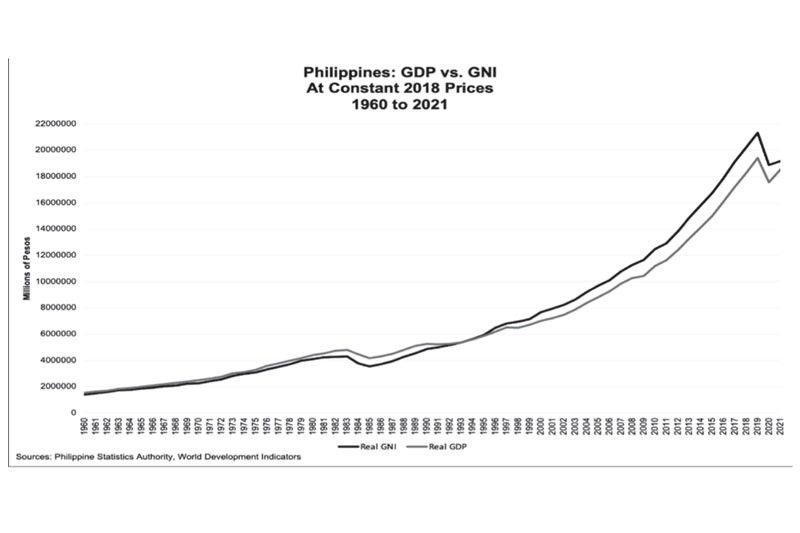The OFW phenomenon

(Continued)
(Part of the paper I am preparing in connection with the 50 year review of economic policy at the UP School of Economics.)
Origin of OFW tracking. Sometime in the mid-1970s, former secretary of labor Blas Ople was apprised of the crisis in the supply of seamen in the world’s shipping industry. He proposed that the government undertake a more serious approach toward establishing a supply of mariners by training them in the country.
Almost simultaneously during that period, a large need for construction workers also emerged in the Middle East. Sudden enrichment of many energy-exporting countries due to the massive increases in the export price of their products had created new building projects in their countries. At the same time, progress in other countries was also causing labor supply tightness, so new markets for employment of foreigners in their workplace were opening.
The foreign employment option. The brain drain has always been with us. For many years since independence, some of our countrymen have searched for work abroad and have never returned. The OFW phenomenon is different. Most of them have to return because they have fixed contracts in terms of years or period of stay.
The Philippine response to bulk demand for foreign workers was to create a new office to manage foreign labor migration. This led to the creation of the POEA (Philippine Overseas Employment Administration) to help promote foreign employment and to create employment for Filipinos to make them more prosperous.
Overseas employment was seen as a temporary stop-gap measure in the meantime that the domestic economy was not large enough to absorb all the labor skills we were producing at home. The country’s high population results into a labor force supply that cannot be fully employed in the country.
Through the years, the increase in the deployment of OFWs has become a source of foreign exchange earnings for the nation in the form of remittances to family. While the remittances provide income transfers to sustain the consumption expenses of families left behind, the dollar remittances sent home provides for the nation also additional resources that makes possible more consumption or investment. The rise in the number of OFWs has also been a factor in the growth of remittances to the country.
All in all, the yearly remittances have boosted the country’s balance of payments, contributing to the improvement of the country’s macro-fundamentals.
GNI vs GDP. A macro-economic consequence of this new development was the strong shift of the country’s income profile in relation to domestic productivity. The country’s Gross National Income (GNI) has grown faster than the corresponding Gross Domestic Product (GDP). (GNI measures the nation’s output by all its nationals, including those done in other economies. GDP measures total output in the country regardless of who helped to produce it.)
It is now possible to look at a comparison of Philippine GNI compared to GDP. Over time, a large divergence of GNI in relation to GDP has widened to a steady difference of nearly close to 10 percent of the GDP. This has meant that the country’s net income from nationals working abroad and contributing to world output translate as 10 percent additional income to the nation’s income productivity, but not in terms of our domestic output!
The attached figure shows this information from 1960 to 2021. Around the early 1970s, GNI and GDP were almost equal. But from 1995, the GNI began exceeding GDP. This has grown to a nearly 10 percent difference. During the pandemic, the difference dropped a little, but GNI still exceeded GDP.

This phenomenon might look like positively contributing to our overall position in terms of incomes. But it puts us at a disadvantage in terms of domestic productivity. Nearly 10 percent of incomes earned by Filipino factors contributes to world output (because they worked abroad), not to domestic output. Most of our neighbors whose GDP has been rising fast in the course of the past decades have built greater domestic productivity based on the contribution of domestic labor to their own economy. Of course, part of this has been due to the influx of large foreign capital to buttress up the industries that produce domestic products. In their case, the contribution of their labor has been in the growth of many home-grown export-oriented industries that pushed up the country’s export revenues. In short, those that prospered at home by providing domestic employment to their own laborers (and other economic resources used in production) have produced more contribution to output productivity in their own countries.
This is why I view the OFW phenomenon as a perverse form of creating employment abroad. It is perverse from the viewpoint of nation building, in comparison to one that is created out of the growth of the domestic investment market. Those countries that have succeeded in developing a home based domestic employment program have done better than us. The domestic capital formation benefits the home country. The productivity created for workers translate into gains in welfare for the worker and his family more directly. The training effect at home creates a larger and prosperous home community. Therefore, it builds a nation more firmly on sound economic footing.
Despite what I said, a high GNI exceeding the GDP is an asset of great value.
For archives of previous Crossroads essays, go to: https://www.philstar.com/authors/1336383/gerardo-p-sicat. Visit this site for more information, feedback and commentary: http://econ.upd.edu.ph/gpsicat/
- Latest
- Trending



























